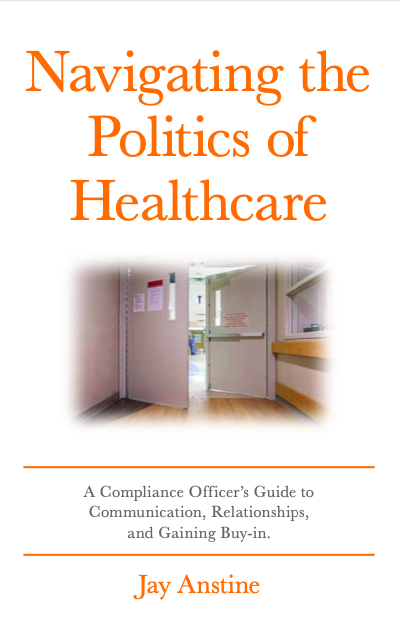Working with uncertainty is something that compliance officers face on a daily basis. For example, regulations and policies are often written to cover many scenarios—except for the one that’s right in front of you.
Am I right?
In the business of healthcare, operational leaders seek clear-cut answers, but sometimes it’s a struggle to find a definitive one and feel settled in the process. While navigating grey areas can be tricky, this article will cover four strategies that can help you become more comfortable in the face of ambiguity—and relatedly, make your leaders feel the same way.
#1—Understand All Points-of-View (POV)
Here, you want to factor in the feedback, insights, and opinions of others—including the ones that differ from your own. While, that may sound like a no-brainer, let’s dig a little deeper.
In my experience with navigating the corporate politics of healthcare, I have found that understanding POV means knowing an individual’s position and interest. Relatedly, it becomes important to recognize the difference between the two.
A position is what someone says they want. For example, a COO says “We want to partner with this physician group to bring a new service line to our patients”. An interest on the other hand, is “the why” behind whatever it is that they want. In this case, let’s assume the COO is seeking to fulfill a performance goal established by the CEO. Positions tend to be communicated, whereas interests are often hidden. To that end, if the interest is not publicly known, you may have to dig for it by identifying it with the individual offline.
If learning how to understand POV is an area you wish to improve, here are some tips that will help:
Listen to Understand. Take the time to listen to different perspectives in order to understand where others are coming from (i.e., identify the positions and interests).
Practice Empathy. Put yourself in the shoes of others to better understand their perspectives and motivations (e.g., how might I interpret this regulation as a COO who wants to do the deal).
Ask Questions. To identify an interest, consider asking questions such as, “From your perspective, what will happen if we’re not able to resolve this issue?”
2—Evaluate the Consequences
In the world of healthcare compliance, decisions matter. When you consider the business of healthcare is highly regulated, heavily rooted in logistics, and deeply personal when it comes to serving patients—the stakes are high.
Whether it’s navigating a regulatory change, choosing how to respond to a HIPAA violation, or determining the scope of an audit, our actions can have ripple effects that extend beyond the immediate issue. To that end, compliance officers need to be thinking about questions like:
What is the risk to organization (e.g., legally, financially, reputationally)?
What is the risk to patient care?
What is the risk to my job, my supervisor’s job, and on up the organizational chart?
The unfortunate reality of our work is that it takes time to develop the skills needed to evaluate the consequences of different actions. That said, here are some tips that can help:
Consider Outcomes. Think about potential outcomes and weigh the consequences of different actions.
Find the Balance. Consider what is required, along with what is ethically sound and operationally feasible— that means taking a moment to ask, “What happens next if we choose this path?”)
Discuss With Your Supervisor. Talk with your supervisor about these questions and your responses—before you act.
This strategy could be summed in four words—“consider the big picture”. If this is an area that you struggle with, then check out a companion article I wrote a couple years ago about taking a big picture approach to compliance.
#3—Engage in Critical Thinking.
While knowledge of the regulations is undoubtedly essential to our role, there is one skill that I think that stands out as indispensable—critical thinking.
Critical thinking is a cognitive process that involves analyzing, evaluating, and synthesizing information to make informed decisions and solve problems. It's a skill that allows an individual to assess information, identify flaws, and make reasoned judgments.
Regardless of what you are working on, approach the gathering of information by questioning the quality, validity and reliability of sources and statements. Consider potential biases, and, ahem—question your own biases too—as well as weighing the merits of conflicting arguments.
Critical thinking helps you organize your thoughts, consider others’ perspective, and anticipate counterarguments. Going through this process will get you to a place where you’ll feel you can defend your decision.
If critical thinking is a muscle for you that needs developing, here are some tips that will help:
Ask Questions…But in The Right Way. Ask more questions (but be curious and not judgmental in your approach).
Challenge Assumptions. Identify your assumptions and question them.
Obtain Feedback. Seek the feedback, insights, and opinions of others, especially those with a differing view.
#4—Challenge Your Assumptions.
As compliance officers, challenging your assumptions is a critical skillset for things like conducting investigations or audits. It also comes in handy when advising healthcare leaders as to whether or not their business decisions are compliant (similar to my COO hypothetical above).
To that end, it’s worth noting that identifying your assumptions, and asking why you believe in them, can help you in navigating the grey. Going through these motions can help you identify if your evidence rooted in fact or opinion, which can help guide you to a place of feeling more secure in your conclusion.
If challenging assumptions is, well, a challenge for you, then here are some tips that can help:
Maintain awareness. The first step towards challenging an assumption is recognizing when you have made one. Here, you want to start by identifying the thought processes that are leading you to make an assumption.
Examine the Evidence. When you do identify an assumption, ask why you believe in it? What evidence has led you to this assumption?
Seek Out Contradictory Evidence. Actively search for evidence that contradicts your assumption. The takeaway here is don’t get so blinded your own argument that you can’t see the other side.
If you’d like some additional strategies for challenging assumptions, you can consult a companion article I wrote on this topic back in 2023.
Pulling it All Together
Learning how to navigate grey areas is a valuable skill, allowing for flexibility, open-mindedness, and personal growth. It enable us to navigate complex regulations, interpret requirements and resolve intricate problems by assessing information and make reasoned judgments.
Simply put, it’s a skillset essential for the effectiveness of any compliance officer.
Navigating ambiguity can be challenging though. By incorporating these strategies, you will evolve to a place of embracing the grey areas with confidence and resilience unlocking your potential for a brighter future.
You can quote the regs.
You know the OIG’s priorities.
You’re up to speed on the latest NCD/LCD changes.
But…leadership still isn’t listening.
Why?
Because knowing the rules isn’t enough.
Healthcare leaders make decisions based on risk, relationships, and results.
That’s exactly why I created this new free 30 training—Why Healthcare Leaders Resist Compliance—And How to Change That.
To learn more, check out the link below…
Are you struggling to communicate with the leaders in your healthcare organization?
If so, check out my new self-study course and earn CEUs while you’re at it.
Did you find this article helpful?
If so, check out my new book.
It contains proven relationship-building strategies to help improve buy-in to your compliance program.
NOTE: Bulk order discounts are now available—contact me at janstine@bluebirdhealthlaw.com for more details.
TAIL




